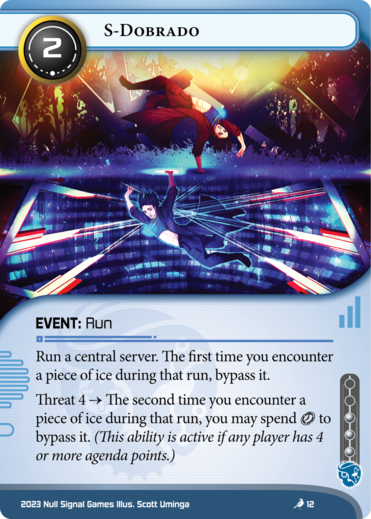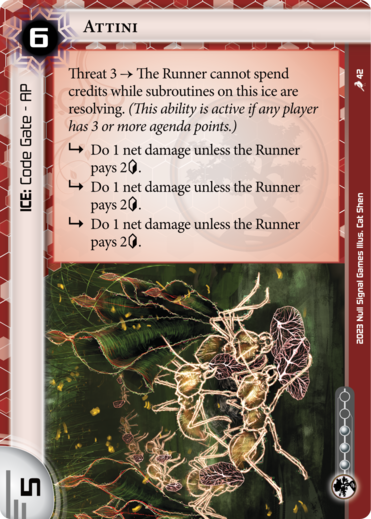“When did the future switch from being a promise to being a threat?”
Chuck Palahniuk, Invisible Monsters
Hi, I am ZiNOS, Developer for Null Signal Games. Today we are going to talk about a new mechanic so elegant and simple you will think it could have been included in System Gateway, but with so much potential to create tense and interesting gameplay patterns that it promises to make some Noise!
One of the problems with card games, and the 3rd most commonly-cited excuse for a loss, is luck of the draw. Customizable card games in particular suffer from this, as cards that can be played early in the game become irrelevant if drawn later in the game, and cards that would be beneficial late in the game or even help the player win altogether, are expensive or unplayable early on. In both cases, the cards that were drawn in the “wrong order” are considered missed opportunities that just fill the player’s hand. The late game ones may prove to be useful later in the game, but you will often lose before reaching that point.
During the early stage of the Liberation cycle, June Cuervo, the Lead Designer at that time, proposed the idea of a mechanic that scales off the current score, paired with the promising name Threat. That was the prompt for the design team, which after some time came up with Threat in its current form. To define it as it will appear in the rules inserts of the pack:
The threat level is the greatest number of agenda points in any player’s score area. For example, if the Runner has 4 agenda points and the Corp has 3 agenda points, the threat level is 4.
Threat abilities are marked with a new ability flag, “Threat N → “, and are only active if the threat level is equal to or greater than the given number N. If the threat level is less than N, the corresponding ability is inactive and cannot be triggered or applied to the game state.
The threat mechanic is designed to work both on Corp and Runner cards. In the Liberation Cycle, it is found on various different card types.
Without further delay, here are some examples.
Meet S-Dobrado, AKA “Indoor Job”*
(*Goofy playtest names and silly playtest art is 50% the fun of being a playtester. The other half is trying to break a card or a mechanic, which can feel like operating a wrecking ball. If you like the sound of any of the above, you should consider applying for playtesting at NSG.)
How can you make Inside Job more threatening? By adding more bypass of course! You can still use the card as an Inside Job (for centrals only though, you can’t use it to trash the pesky turn 1 Rashida hiding behind that remote ice), but once either player has reached 4 or more agenda points, not even two ice can stop you from breaching a central! Using it as Mercury, the new Criminal ID from the Automata Initiative, can allow you to secure an additional access even in the mid-game, when rezzed ice is protecting all of the Corp’s central servers. And if an additional access doesn’t sound like a threat to you, please refer here to see what can happen to your face when you allow an extra access too often!
Introducing Attini, AKA how to make an AP ice without accidentally killing the runner on the first turn.
Code Gates with the AP subtype have often been the cause of frustration, as even a prudent Runner who ensures they run with a killer installed can be flatlined by a DNA Tracker or similar early in the game. Even if they don’t do enough damage to kill, the tempo loss of such a facecheck can often make it impossible to recover for the rest of the game. This has meant that AP ice with formidable facechecks often have highly inflated rez costs to keep the threat of flatline in check. Attini is a medium to high cost ice that cannot kill early on (provided the runner has enough credits), but becomes much more dangerous as soon as either player reaches 3 or more agenda points. While, below that threat level, the Runner could simply pay their way through an Attini, at threat 3 or higher it becomes far too damaging to run without a decoder installed. The threat mechanic, when used on ice, can make them gain power during the course of the game, or even gain new roles and uses as the game progresses. While Attini is a taxing ice to pay through from the outset, when the threat level reaches 3 the now-unavoidable damage essentially turns it into a gearcheck requiring you to find a way to break it.
As more cards are revealed during this preview season, you’ll see many more and varied uses of the threat mechanic on various different card types. It can blur the boundaries between early game and late game cards, allowing their use case to change and their power level to scale with the game state, so that they remain relevant for a greater part of the game. Design and Development had a great time finding interesting ways of incorporating threat in the Liberation Cycle, and we look forward to using it more in future sets. And you can take that as a threat!


